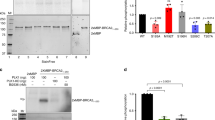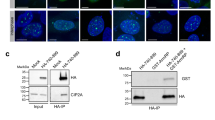Abstract
Loss-of-function of caretaker genes characterizes a group of cancer predisposition diseases that feature cellular hypersensitivity to DNA damage and chromosome fragility; this group includes Fanconi anaemia and Bloom syndrome1,2,3. The products of the 13 FANC genes4 (mutated in Fanconi anaemia), which constitute the 'FANC' pathway, and BLM (the RecQ helicase mutated in Bloom syndrome) are thought to collaborate during the S phase of the cell cycle, preventing chromosome instability. Recently, BLM has been implicated in the completion of sister chromatid separation during mitosis, a complex process in which precise regulation and execution is crucial to preserve genomic stability. Here we show for the first time a role for the FANC pathway in chromosome segregation during mitotic cell division. FANCD2, a key component of the pathway, localizes to discrete spots on mitotic chromosomes. FANCD2 chromosomal localization is responsive to replicative stress and specifically targets aphidicolin (APH)-induced chromatid gaps and breaks. Our data indicate that the FANC pathway is involved in rescuing abnormal anaphase and telophase (ana-telophase) cells, limiting aneuploidy and reducing chromosome instability in daughter cells. We further address a cooperative role for the FANC pathway and BLM in preventing micronucleation, through FANC-dependent targeting of BLM to non-centromeric abnormal structures induced by replicative stress. We reveal new crosstalk between FANC and BLM proteins, extending their interaction beyond the S-phase rescue of damaged DNA5,6 to the safeguarding of chromosome stability during mitosis.
This is a preview of subscription content, access via your institution
Access options
Subscribe to this journal
Receive 12 print issues and online access
$209.00 per year
only $17.42 per issue
Buy this article
- Purchase on Springer Link
- Instant access to full article PDF
Prices may be subject to local taxes which are calculated during checkout





Similar content being viewed by others
References
D'Andrea, A. D. & Grompe, M. The Fanconi anaemia/BRCA pathway. Nature Rev. Cancer 3, 23–34 (2003).
Kinzler, K. W. & Vogelstein, B. Cancer-susceptibility genes. Gatekeepers and caretakers. Nature 386, 761–763 (1997).
Ellis, N. A. et al. The Bloom's syndrome gene product is homologous to RecQ helicases. Cell 83, 655–666 (1995).
Wang, W. Emergence of a DNA-damage response network consisting of Fanconi anaemia and BRCA proteins. Nature Rev. Genet. 8, 735–748 (2007).
Meetei, A. R. et al. A multiprotein nuclear complex connects Fanconi anemia and Bloom syndrome. Mol. Cell Biol. 23, 3417–3426 (2003).
Pichierri, P., Franchitto, A. & Rosselli, F. BLM and the FANC proteins collaborate in a common pathway in response to stalled replication forks. EMBO J. 23, 3154–3163 (2004).
Meetei, A. R., Yan, Z. & Wang, W. FANCL replaces BRCA1 as the likely ubiquitin ligase responsible for FANCD2 monoubiquitination. Cell Cycle 3, 179–181 (2004).
Andreassen, P. R., D'Andrea, A. D. & Taniguchi, T. ATR couples FANCD2 monoubiquitination to the DNA-damage response. Genes Dev. 18, 1958–1963 (2004).
Garcia-Higuera, I. et al. Interaction of the Fanconi anemia proteins and BRCA1 in a common pathway. Mol. Cell 7, 249–262 (2001).
Pichierri, P. & Rosselli, F. The DNA crosslink-induced S-phase checkpoint depends on ATR-CHK1 and ATR-NBS1-FANCD2 pathways. EMBO J. 23, 1178–1187 (2004).
Guervilly, J. H., Mace-Aime, G. & Rosselli, F. Loss of CHK1 function impedes DNA damage-induced FANCD2 monoubiquitination but normalizes the abnormal G2 arrest in Fanconi anemia. Hum. Mol. Genet. 17, 679–689 (2008).
Wang, X. et al. Chk1-mediated phosphorylation of FANCE is required for the Fanconi anemia/BRCA pathway. Mol. Cell Biol. 27, 3098–3108 (2007).
Bogliolo, M. et al. Histone H2AX and Fanconi anemia FANCD2 function in the same pathway to maintain chromosome stability. EMBO J. 26, 1340–1351 (2007).
Tutt, A. et al. Absence of Brca2 causes genome instability by chromosome breakage and loss associated with centrosome amplification. Curr. Biol. 9, 1107–1110 (1999).
Daniels, M. J., Wang, Y., Lee, M. & Venkitaraman, A. R. Abnormal cytokinesis in cells deficient in the breast cancer susceptibility protein BRCA2. Science 306, 876–879 (2004).
Joukov, V. et al. The BRCA1/BARD1 heterodimer modulates ran-dependent mitotic spindle assembly. Cell 127, 539–552 (2006).
Chan, K. L., North, P. S. & Hickson, I. D. BLM is required for faithful chromosome segregation and its localization defines a class of ultrafine anaphase bridges. EMBO J. 26, 3397–3409 (2007).
Kalb, R. et al. Hypomorphic mutations in the gene encoding a key Fanconi anemia protein, FANCD2, sustain a significant group of FA-D2 patients with severe phenotype. Am. J. Hum. Genet. 80, 895–910 (2007).
Chan, G. K., Jablonski, S. A., Sudakin, V., Hittle, J. C. & Yen, T. J. Human BUBR1 is a mitotic checkpoint kinase that monitors CENP-E functions at kinetochores and binds the cyclosome/APC. J. Cell Biol. 146, 941–954 (1999).
Ciferri, C. et al. Architecture of the human ndc80-hec1 complex, a critical constituent of the outer kinetochore. J. Biol. Chem. 280, 29088–29095 (2005).
Ichijima, Y. et al. Phosphorylation of histone H2AX at M phase in human cells without DNA damage response. Biochem. Biophys. Res. Commun. 336, 807–812 (2005).
Suzuki, M., Suzuki, K., Kodama, S. & Watanabe, M. Phosphorylated histone H2AX foci persist on rejoined mitotic chromosomes in normal human diploid cells exposed to ionizing radiation. Radiat. Res. 165, 269–276 (2006).
Howlett, N. G., Taniguchi, T., Durkin, S. G., D'Andrea, A. D. & Glover, T. W. The Fanconi anemia pathway is required for the DNA replication stress response and for the regulation of common fragile site stability. Hum. Mol. Genet. 14, 693–701 (2005).
Fenech, M. Cytokinesis-block micronucleus cytome assay. Nature Protoc. 2, 1084–1104 (2007).
Rosin, M. P. & German, J. Evidence for chromosome instability in vivo in Bloom syndrome: increased numbers of micronuclei in exfoliated cells. Hum. Genet. 71, 187–191 (1985).
Baumann, C., Korner, R., Hofmann, K. & Nigg, E. A. PICH, a centromere-associated SNF2 family ATPase, is regulated by Plk1 and required for the spindle checkpoint. Cell 128, 101–114 (2007).
Porfirio, B. et al. Fragile sites and chromosome instability: the distribution of breaks induced by cis-diamine-dichloro-platinum (II) in Fanconi anemia lymphocyte cultures. Hum. Genet. 86, 256–260 (1991).
Fundia, A., Gorla, N. & Larripa, I. Spontaneous chromosome aberrations in Fanconi's anemia patients are located at fragile sites and acute myeloid leukemia breakpoints. Hereditas 120, 47–50 (1994).
Maluf, S. W. & Erdtmann, B. Genomic instability in Down syndrome and Fanconi anemia assessed by micronucleus analysis and single-cell gel electrophoresis. Cancer Genet. Cytogenet. 124, 71–75 (2001).
Willingale-Theune, J. et al. Ultrastructure of Fanconi anemia fibroblasts. J. Cell Sci. 93 (Pt 4), 651–665 (1989).
Walpita, D., Plug, A. W., Neff, N. F., German, J. & Ashley, T. Bloom's syndrome protein, BLM, colocalizes with replication protein A in meiotic prophase nuclei of mammalian spermatocytes. Proc. Natl Acad. Sci. USA 96, 5622–5627 (1999).
Acknowledgements
We thank all the past and present members of F. Rosselli's team for technical support and helpful discussions, J. Soulier and D. Briot for the FA-C complemented cell lines, E. Nigg for the anti-PICH antibody, Y. Lecluse for FACS analysis, A. Jalil for help with confocal microscopy and P. Kannouche for providing materials and technical advice. This work was supported by grants from La Ligue Contre le Cancer (Equipe Labellisée 2006 and 2009), Electricité de France (EDF) and Institut Nationale pour le Cancer (INCa) to F.R., and a fellowship from INCa-Lilly to V.N.
Author information
Authors and Affiliations
Contributions
V.N. performed experiments and V.N. and F.R. conceived and designed research, performed data analysis and wrote the manuscript.
Corresponding author
Ethics declarations
Competing interests
The authors declare no competing financial interests.
Supplementary information
Supplementary Information
Supplementary Information (PDF 1129 kb)
Rights and permissions
About this article
Cite this article
Naim, V., Rosselli, F. The FANC pathway and BLM collaborate during mitosis to prevent micro-nucleation and chromosome abnormalities. Nat Cell Biol 11, 761–768 (2009). https://doi.org/10.1038/ncb1883
Received:
Accepted:
Published:
Issue Date:
DOI: https://doi.org/10.1038/ncb1883
This article is cited by
-
UBE2T resolves transcription-replication conflicts and protects common fragile sites in primordial germ cells
Cellular and Molecular Life Sciences (2023)
-
Effects of aneuploidy on cell behaviour and function
Nature Reviews Molecular Cell Biology (2022)
-
FANCD2 promotes mitotic rescue from transcription-mediated replication stress in SETX-deficient cancer cells
Communications Biology (2022)
-
Beyond DNA repair and chromosome instability—Fanconi anaemia as a cellular senescence-associated syndrome
Cell Death & Differentiation (2021)
-
Fanconi anemia proteins participate in a break-induced-replication-like pathway to counter replication stress
Nature Structural & Molecular Biology (2021)



